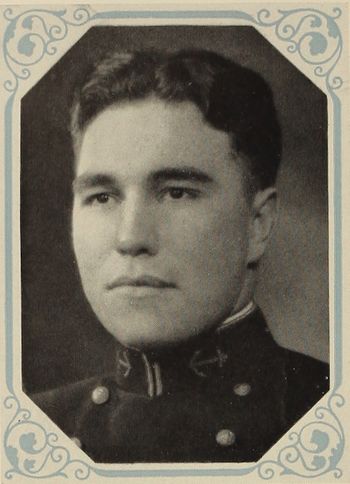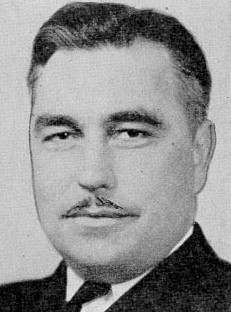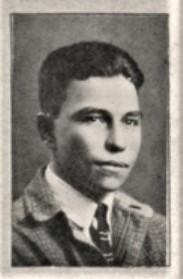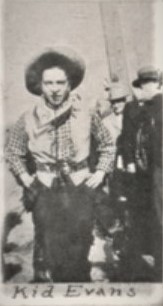ERNEST E. EVANS, CDR, USN
Ernest Evans '31
Lucky Bag
From the 1931 Lucky Bag:
Ernest Edwin Evans
Muskogee, Oklahoma
"Big Chief" "Chief" "Cherokee"
One Friday, the thirteenth, thirteen lively pounds of human "Chief" entered this old world. Superstitious? Not Chief! Radical from birth, he manifested his desire for travel, education, and militarism by joining the Oklahoma National Guard and finally the Navy.
As a plebe, Chief thought his military life was just "one bust after another", but coming through that year with a philosophy of "life is what one makes it", he established himself in the heart of every Middie.
Endowed with an exceptionally brilliant mind, he advocates and practices a minimum of study and a maximum of reading and pleasure. This policy has enabled him to develop a shining personality and pleasant nature, together with a knowledge of psychology, religion, philosophy, love, or most any subject about which one desires to converse.
As a wife he is reliable, big-hearted, and consistent, full of good jokes, "lend me two bits, pal, so I can call Baltimore," laughs and sorrows, never gripes, always ambitious.
Wrestling 4; Class Football 3, 2, 1; Gymkhana 4

Ernest Edwin Evans
Muskogee, Oklahoma
"Big Chief" "Chief" "Cherokee"
One Friday, the thirteenth, thirteen lively pounds of human "Chief" entered this old world. Superstitious? Not Chief! Radical from birth, he manifested his desire for travel, education, and militarism by joining the Oklahoma National Guard and finally the Navy.
As a plebe, Chief thought his military life was just "one bust after another", but coming through that year with a philosophy of "life is what one makes it", he established himself in the heart of every Middie.
Endowed with an exceptionally brilliant mind, he advocates and practices a minimum of study and a maximum of reading and pleasure. This policy has enabled him to develop a shining personality and pleasant nature, together with a knowledge of psychology, religion, philosophy, love, or most any subject about which one desires to converse.
As a wife he is reliable, big-hearted, and consistent, full of good jokes, "lend me two bits, pal, so I can call Baltimore," laughs and sorrows, never gripes, always ambitious.
Wrestling 4; Class Football 3, 2, 1; Gymkhana 4
Loss
From Wikipedia:
In the Battle off Samar, a part of the Battle of Leyte Gulf, Evans fought his ship gallantly until it was sunk on October 25, 1944, by a Japanese force that was vastly superior in number, firepower, and armor. Johnston, together with the destroyers Hoel and Heermann, four destroyer escorts and six escort carriers (CVEs) formed the task unit 77.4.3, known as Taffy 3. This group, together with planes from Taffy 2 (TU 77.4.2), ultimately forced a Japanese battlegroup consisting of several battleships, heavy cruisers, light cruisers and destroyers to abort its original mission to attack the landing beaches at Leyte under the command of General Douglas MacArthur and retreat.
When the Japanese fleet during the Battle off Samar was first sighted, Evans did not hesitate. He ordered his helm sharp to port and he led his destroyer out of the task unit's circular antiaircraft disposition in favor of charging the enemy alone to make a torpedo attack. Some claim that Evans told his crew over the ship's intercom: "A large Japanese fleet has been contacted. They are fifteen miles away and headed in our direction. They are believed to have four battleships, eight cruisers, and a number of destroyers. This will be a fight against overwhelming odds from which survival cannot be expected. We will do what damage we can." However, contemporaneous sources credit the latter part of this dramatic announcement to LCDR Robert W. Copeland of the Samuel B. Roberts, who charged in with Evans on a subsequent torpedo run.
The fate of the Johnston's captain was never conclusively established, and remains the subject of continuing conjecture among the ship's survivors. Some claim that he was hit by Japanese naval shellfire; others that he was able to jump into a damaged motor whaleboat. What is known is that he was seriously wounded during the battle; that he lived long enough to give the abandon ship order; and that he was not among those rescued. Evans was posthumously awarded the Medal of Honor for his material contribution to the decisive victory won in Leyte Gulf and shared in the Presidential Unit Citation awarded his group for this action in which he gave his life.
The outstanding book "The Last Stand of the Tin Can Sailors" has much more about Evans during this action. A full biography, Destroyer Captain: The Life of Ernest E. Evans, was published in August 2024.
Other Information
From Naval History and Heritage Command:
Ernest Edwin Evans, a half-Cherokee Indian and one-quarter-Creek Indian, was born on 13 August 1908 in Pawnee, Oklahoma. He graduated from Central High School in Muskogee, Oklahoma and on 29 May 1926 enlisted in the US Navy. After a year's service as an enlisted man, he was appointed to the US Naval Academy, Annapolis, Maryland, from the Navy at large and entered as a Midshipman on 29 June 1927. He graduated with the degree of Bachelor of Science and commissioned Ensign in the US Navy on 4 June 1931, and by subsequent promotion attained the rank of Commander to date from 1 November 1942.
After graduation from the Naval Academy in June 1931, he was assigned to the Naval Air Station, San Diego, California, for a year, and thereafter, until 7 August 1933, served consecutively in USS Colorado, USS Roper and USS Rathburne. After service at the Naval Air Station, Pensacola, Florida, he joined the USS Pensacola, and six months later became Aviation Gunnery Observer of that cruiser's Scouting Squadron NINE. He served in that capacity until 15 April 1937, then continued sea duty for four years, serving successively in the USS Chaumont, USS Cahokia and USS Black Hawk.
From Wikipedia:
On 9 August 1941, he was assigned to the destroyer Alden, and was serving on her in the East Indies when the Japanese attacked Pearl Harbor on December 7 of that year. He became commanding officer of Alden on 14 March 1942, and held that position until 7 July 1943. While serving on Alden he participated in operations in and around Australia, New Guinea and the Dutch East Indies.
In mid-1943 Evans was then ordered to duty in charge of fitting out the Fletcher-class destroyer Johnston at the Seattle-Tacoma Shipbuilding Corporation in Seattle, Washington. Commander Evans assumed command of Johnston at her commissioning on 27 October 1943. He was awarded the Bronze Star for meritorious achievement in action against a Japanese submarine on May 16, 1944.
From The Tulsa World, May 24, 1945 via researcher Kathy Franz:
Exploits of a Tulsan, Comdr. Ernest E. Evans, 34 years old, who has been missing in action since his ship, the USS Johnston, was sunk after a thrilling engagement with an overwhelming Jap naval force in October, 1944, are detailed in the current Saturday Evening Post. [May 26, 1945]
The article, “We Asked for the Jap Fleet – and Got It,” forms the lead story in the periodical. It was written by Sidney Shalett from an interview with Lieut. Robert C. Hagen, USNR.
“Well Hagen, we’re within three days of being one year old,” Commander Evans is quoted as having remarked to his executive officer while the destroyer was 51 miles of Samar Island. “It’s been an uneventful year.”
“The Skipper was a fighting man from the soles of his broad feet to the ends of his straight black hair. He was an Oklahoman and proud of the Indian blood he had in him. We called him – though not to his face – the Chief. The Johnston was a fighting ship but he was the heart and soul of her.”
Lieutenant Hagen gives full credit to the fighting heart of the lost destroyer to Commander Evans.
“The Johnston was commissioned on October 27, 1943.” Hagen is quoted. “I remember a prophetic line from the skipper’s speech. ‘This is going to be a fighting ship. I intend to go in harm’s way, and anyone who doesn’t want to go along had better get off right now.’”
The entire fighting history of the Johnston is detailed in the article, the full 363 days of it from its bombardment of the beaches of Kwajalein three months after it was commissioned until it sank under the salute of Japanese captain who paid it homage as it went down.
From researcher Kathy Franz:
Ernest graduated from Central high school in Muskogee in 1926. College Preparatory. Norman Meet ’25; “M” Service Club ’25, ’26 (treasurer); Forum ’25, ’26; Scout Staff ’26; Press Association ’26; Latin Club ’25; Senior Pin and Ring Committee ’26; House of Representatives ’24. “He has the courage of his convictions.” Ernest played the role of Mills in the senior play “The Man of the Hour.” Hobo Day was April 1, 1926.
His wife was Margaret Bell. In 1945, their sons were Ernest E., Jr., 13, and Jerry David, 12.
His mother was Anna, and his father Charles William was a street car motorman in 1920. Ernest's brother was George Lee, and his sisters were Mary (Mrs. Hugh Hendrickson) and Mrs. Janie Crosbie.
His wife was listed as next of kin.
Medal of Honor
From Hall of Valor:
The President of the United States of America, in the name of Congress, takes pride in presenting the Medal of Honor (Posthumously) to Commander Ernest Edwin Evans (NSN: 0-70042), United States Navy, for conspicuous gallantry and intrepidity at the risk of his life above and beyond the call of duty as Commanding Officer of the U.S.S. JOHNSTON (DD-557) in action against major units of the enemy Japanese fleet during the battle off Samar on 25 October 1944. The first to lay a smokescreen and to open fire as an enemy task force, vastly superior in number, firepower and armor, rapidly approached. Commander Evans gallantly diverted the powerful blasts of hostile guns from the lightly armed and armored carriers under his protection, launching the first torpedo attack when the JOHNSTON came under straddling Japanese shellfire. Undaunted by damage sustained under the terrific volume of fire, he unhesitatingly joined others of his group to provide fire support during subsequent torpedo attacks against the Japanese and, out-shooting and outmaneuvering the enemy as he consistently interposed his vessel between the hostile fleet units and our carriers despite the crippling loss of engine power and communications with steering aft, shifted command to the fantail, shouted steering orders through an open hatch to men turning the rudder by hand and battled furiously until the JOHNSTON, burning and shuddering from a mortal blow, lay dead in the water after three hours of fierce combat. Seriously wounded early in the engagement, Commander Evans, by his indomitable courage and brilliant professional skill, aided materially in turning back the enemy during a critical phase of the action. His valiant fighting spirit throughout this historic battle will venture as an inspiration to all who served with him.
Service: Navy
Rank: Commander
Bronze Star
From and Heritage Command:
He was awarded the Bronze Star Medal with Combat "V," for "meritorious achievement as Commanding Officer of the USS Johnston in action against an enemy Japanese submarine on May 16, 1944..." The citation further states:
Participating in a search and attack mission, Commander Evans skillfully maneuvered his ship into position to gain sound contact and delivered a vigorous depth-charge attack. Quickly regaining contact, he again dropped his depth charges which resulted in a heavy underwater ripple explosion heard five minutes after the last detonation with the appearance later of debris and a heavy oil slick in the vicinity as evidence of the probable sinking of the enemy submarine. Commander Evans' persistent tactics and his effective coordination with the assisting ships of the search and attack group were contributing factors in the success of a vital mission and in keeping with the highest traditions of the U.S. Naval Service."
Photographs
Namesake
USS Evans (DE 1023) was named for Ernest; the ship was sponsored by his sister.
USS Johnston (DD 557) Location
Ernest's ship was located four miles below the surface of the Philippine Sea in 2001.
The "Register of Commissioned and Warrant Officers of the United States Navy and Marine Corps" was published annually from 1815 through at least the 1970s; it provided rank, command or station, and occasionally billet until the beginning of World War II when command/station was no longer included. Scanned copies were reviewed and data entered from the mid-1840s through 1922, when more-frequent Navy Directories were available.
The Navy Directory was a publication that provided information on the command, billet, and rank of every active and retired naval officer. Single editions have been found online from January 1915 and March 1918, and then from three to six editions per year from 1923 through 1940; the final edition is from April 1941.
The entries in both series of documents are sometimes cryptic and confusing. They are often inconsistent, even within an edition, with the name of commands; this is especially true for aviation squadrons in the 1920s and early 1930s.
Alumni listed at the same command may or may not have had significant interactions; they could have shared a stateroom or workspace, stood many hours of watch together… or, especially at the larger commands, they might not have known each other at all. The information provides the opportunity to draw connections that are otherwise invisible, though, and gives a fuller view of the professional experiences of these alumni in Memorial Hall.
July 1931
October 1931
January 1932
April 1932
October 1932
January 1933
April 1933
July 1933
October 1933
April 1934
LTjg Oscar Pate, Jr. '27
LTjg Leonard Southerland '27
LTjg Frank Highley, Jr. '30
LTjg Robert Patten '30
LTjg Claud Hughes '30
LTjg Baylies Clark '30
October 1934
January 1935
April 1935
October 1935
January 1936
April 1936
July 1936
January 1937
April 1937
September 1937
January 1938
July 1938
January 1939
October 1939
June 1940
November 1940
April 1941

The "category" links below lead to lists of related Honorees; use them to explore further the service and sacrifice of alumni in Memorial Hall.



